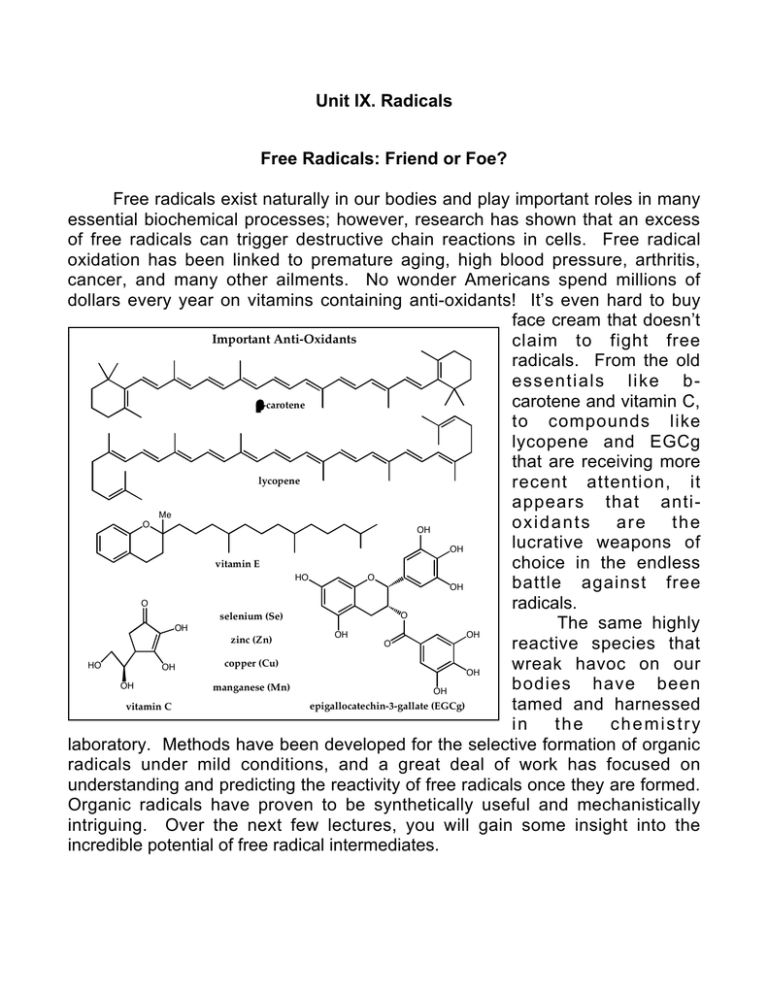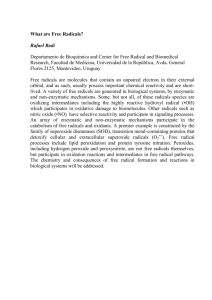Unit IX. Radicals Free Radicals: Friend or Foe?
advertisement

Unit IX. Radicals Free Radicals: Friend or Foe? Free radicals exist naturally in our bodies and play important roles in many essential biochemical processes; however, research has shown that an excess of free radicals can trigger destructive chain reactions in cells. Free radical oxidation has been linked to premature aging, high blood pressure, arthritis, cancer, and many other ailments. No wonder Americans spend millions of dollars every year on vitamins containing anti-oxidants! It’s even hard to buy face cream that doesn’t Important Anti-Oxidants claim to fight free radicals. From the old essentials like bcarotene and vitamin C, b-carotene to compounds like lycopene and EGCg that are receiving more lycopene recent attention, it appears that anti Me O oxidants are the OH lucrative weapons of OH vitamin E choice in the endless HO O battle against free OH O radicals. O selenium (Se) The same highly OH OH OH zinc (Zn) O reactive species that copper (Cu) HO wreak havoc on our OH OH OH bodies have been manganese (Mn) OH epigallocatechin-3-gallate (EGCg) tamed and harnessed vitamin C in the chemistry laboratory. Methods have been developed for the selective formation of organic radicals under mild conditions, and a great deal of work has focused on understanding and predicting the reactivity of free radicals once they are formed. Organic radicals have proven to be synthetically useful and mechanistically intriguing. Over the next few lectures, you will gain some insight into the incredible potential of free radical intermediates. IX. Radicals A. Introduction 1. Structure 2. Stability B. Generation of Radicals 1. Thermal Bond Cleavage a. Acyl Peroxide b. Alkyl Peroxide c. Halides d. Azo Compounds 2. Photochemical Cleavage 3. Electron Transfer C. Termination Reactions 1. Combination 2. Disproportionation D. Propagation Reactions 1. Abstraction a. Selectivity b. Intramolecular Abstraction 2. Addition to p bond a. Intermolecular Addition b. Molecules that add to p bonds c. Intramolecular Addition i. Halogen Abstraction with Tin Radical ii. Thermodynamic Considerations 3. Fragmentation a. Mechanism b. Common Fragmentations c. Rate of Fragmentation 4. Rearrangements a. Type 1, X = SR, Br, I b. Type 2, X = vinyl, acyl c. Type 3, X = aryl E. Radical Chain Reactions 1. Chain Length 2. Solvent Effects 3. Cage Effects



